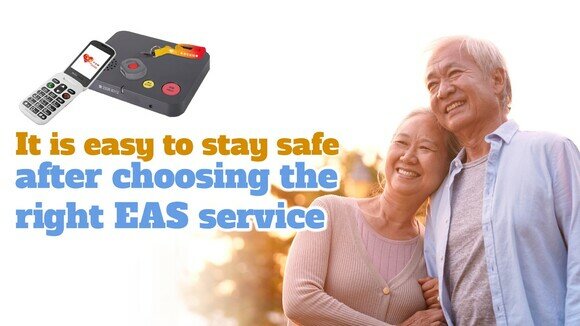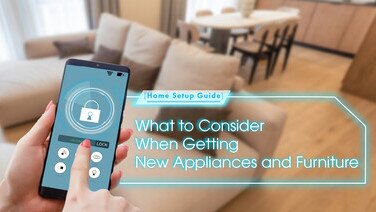Points to consider when choosing a service
1.Types of EAS service
There are two main types of service for indoor and outdoor use, which are further divided into different categories including the following:
a. Indoor type which has to be connected to a fixed line
In addition to the main component, some service providers will supply a waterproof remote control to facilitate elderly users who may carry it around at home. It can also be placed in the bathroom without any problem when they take a bath.
.jpg)
b.Outdoor type(non mobile phone model)
This is designed for use by elderly people who often go out but have difficulty with operating machines. The one-button operation is simple and easy. The user can simply press the only button on the equipment in an emergency. Moreover, various EAS services for outdoor use are equipped with a positioning device so that relatives can find the approximate location of the user at any time.
c.Outdoor-indoor type (smart watch model)
Similar to the non mobile phone model, smart phone models can also be connected to the EAS service with the touch of a button. It is convenient for elderly people who often go out. The watch also features advanced GPS functions which enable the more accurate location of the user.
d.Outdoor type (GSM phone model)
For elderly people who are accustomed to using large fonts, loud sound, big buttons and more traditional mobile phones, this kind of mobile phone would be a relatively familiar choice. This device is equipped with a help button so that in addition to being used as a regular mobile phone, it has an easy-to-operate function for seeking help in an emergency.
e.Outdoor type (EAS App)
Since many elderly people have smart phones and are au fait with their operation, some organisations have launched EAS apps which allow users to use the EAS service as long as they have installed the program on their smart phones. However, it should be noted that a user only found out after buying a new mobile phone that his new phone did not support the EAS service that he had been using. He nearly had to sign a new contract to use an upgraded version of the app before the expiry of the old contract. Therefore, special attention should be paid to program support issues before choosing this kind of service.
Consideration of usage habits
With the advance in technology, EAS services are becoming more and more diversified. Some service providers also offer care service, reminder calls, location checking functions etc. Before making a decision, consumers should consider their actual needs and usage habits such as whether they go out often, their familiarity with the operation of smart phones etc.
Product design
Consumers should also enquire about and consider the following product details:
- Does the product comply with the requirements of the electrical product (safety) regulations?
- Is the remote control waterproof and shockproof?
- Is there any other way to activate the alarm away from the host if the remote control fails?
- The position and size of the help button are different on different models of mobile phones. There is no harm trying to see whether the button can be easily pressed when choosing a model.
- How can the main device be used to contact the support centre?
- Does the system allow the support centre to talk to users like using the telephone or can they only take turns to talk like using a walkie-talkie?
- Is the whole system managed by the same service organization?
- How long does it take the support centre to respond to a call for assistance (e.g. within 3 seconds)? How would it respond in the event of a power outage or system failure?
- How can the power supply to the device be ensured? Are there on-site repair and battery replacement services?
- Some organisations do not recommend the use of EAS mobile phones for people with pacemakers or defibrillators because the electromagnetic fields generated by mobile phones may interfere with the functions of some of these devices. If necessary, users should consult medical professionals or read the product manual of the devices concerned.
The position and size of the help button are different on different models of mobile phones. Consumers should try to see whether the button can be easily pressed when inspecting the mobile phones and deciding whether to use the related service.
2. Scope of service
Currently, in addition to calling for ambulances or the police, notification of emergency contacts, forwarding users’ medical records to emergency departments and other 24-hour emergency support, quite a few companies provide EAS services which include many other services such as making out-patient appointments, regular greeting phone calls, various enquiries, weather alerts and reminders to take medication, and even emotional support etc., thus serving as a virtual assistant.
However, when comparing the scope of services provided by different organisations, consumers should also consider the size and manpower of the suppliers, whether they can provide the services promised and maintain good quality of service. In the past, when introducing EAS service to users, the staff of some organisations claimed to be able to provide regular greeting phone calls. After buying the service, the user found that due to limited staff, the company could only maintain irregular calls 2 to 3 times per month, which did not meet the user’s expectation. Therefore, when selecting services, consumers should ask for relevant details and confirm them in writing at the time of signing the contract.
3.Charges
What is included in the fee?
When shopping for services, remember to take a closer look at what the fee includes. In the case of indoor services, for example, users may need to apply to a telecommunications network operator operating fixed-line services for the use of EAS services, and the fees may not be included in the fees charged by EAS service provider. Moreover, the host device and remote control provided by individual organisations are non-sale items and must be returned if the service is terminated. The host device may not be compatible with the system of other service organisations, so switching to other service organisations may require the use of a new device and additional payment. For mobile phone models of EAS services for outdoor use, the buying and renting charges and maintenance period may also differ. In particular, if users frequently travel to and from the mainland or overseas, they should first check whether the service organisations support non-local services.
Mode of charging
EAS service providers usually charge a monthly fee, or a one-off payment for permanent usage. With regard to the payment of monthly fees, consideration should of course be given to the necessity for prepayment, the length of the contract period, the arrangements for signing a new contract after expiry and so on. In particular, it is important to find out whether the contract can be terminated early and whether additional charges will be incurred. For example, if unfortunately the user passes away during the term of the contract, some organisations may require relatives to pay the remaining fees until the end of the contract period.
Government subsidy
Consumers may have heard that they can apply to the Social Welfare Department, the Housing Department and the Hong Kong Housing Society for subsidies to use the EAS service, and some users can therefore use the service free of charge. However, there have been cases where users immediately signed up after the promotion pitch by salespersons without clarifying the details, only finding out later that they were not eligible to apply for financial assistance, and thus going beyond their budget. Therefore, consumers must check if they meet the specific criteria for applying for allowances, such as age, living conditions, disability and income from assets. It would be prudent to discuss with family members or social workers, or ask them to help clarify the amount of the allowance, the application procedures and application criteria.
Guidelines on the use of EAS service
Indoor use
Whether the supplier's telecommunications equipment is compatible with the EAS | If you intend to change to another fixed-line telephone service provider, you should first check with the new supplier where you want to use the telephone and whether the relevant telecommunications equipment is compatible with the EAS used, and make sure that their network equipment and telephone have a compliant backup power supply for the EAS. |
Test operation
| After the installation of the new telephone, users should immediately test whether the EAS is functioning properly and if it is not functioning properly, the telecommunications network operator and the EAS service support centre should be requested to assist in resolving the problem as soon as possible.
Users should also regularly test the EAS remote control and other accessories at different locations in the home to avoid only finding out that they cannot be used when an accident happens. In addition, users should also regularly arrange for qualified persons to check the electrical accessories of the EAS. |
Take the remote control with you | In the event of an unexpected incident, you can press the button for help immediately and ask the support centre for assistance. |
Do not unplug it | Users should not unplug the EAS when it is idle. Otherwise, the host device will automatically signal the support centre that there is a power outage in the user's home, thus hindering the normal operation of the support centre. |
Outdoor use
Keep an eye on the signal | Mobile phones rely on mobile telecommunications networks to maintain communication with the outside world. Users who are in a location where the signal is weak or unstable may suffer delay in seeking help from the support centre. |
Keep the battery charged | Users should pay attention to whether the phone has a low power warning which prompts them to charge the battery when the power supply is running out so that they will not encounter phone power shortage when they need to call for help. |
[Issue534 of the monthly "Choice Magazine" Details about EAS services should be clarified Discrepancies in expectations may lead to disputes.] (Chinese version only) This article contains several complaints about the use of EAS service for consumers’ reference.
Consumers can also download for free [Issue 404 of the monthly "Choice Magazine" Pressing one button for help: EAS service can be used both indoors and outdoors] (Chinese version only) to learn more about the details of the different EAS service plans.






![[Baby Snacks Guide] Who Says Snacks Can’t Be Healthy?](/f/guide_detail/415742/376c212/bb%20snack.jpg)




